Connecting every village & every rural household with broadband internet has been on the agenda of every government in the last decade. The UPA launched the National Optical Fiber Network which the NDA renamed as BharatNet. What is this program and what is the current status of implementation? Here are the details.
In her budget speech on 01 February 2020, Finance Minister Nirmala Sitharaman stated that the government’s vision is to provide digital connectivity to all public institutions at Gram Panchayat level. For the same, the government has proposed to allocate ₹ 6000 crores in 2020-21 to ‘BharatNet’ programme to link one lakh gram panchayats by providing Fibre to the Home connections (FTTH).
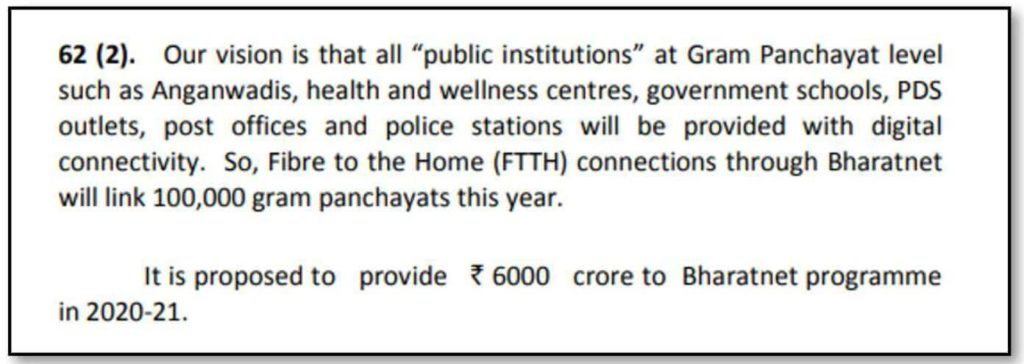
What exactly is BharatNet? When was it conceived and what is the current status of implementation?
BharatNet programme was earlier known as National Optical Fiber Network during the UPA
With a vision to connect over 2,50,000 Gram Panchayats across the country, the Manmohan Singh led UPA government initiated the National Optical Fiber Network (NOFN) programme in 2011. Like in the case of a few other schemes, the Modi government renamed the programme as BharatNet programme. The programme aims at taking broadband connectivity to every nook and corner of the country by using optical fiber. It is considered the biggest rural telecom project in the world. The project is now an integral part of the current government’s Digital India initiative- the flagship programme to empower citizens digitally and to bridge the digital gap between rural and urban India.
Through BharatNet, the government envisages providing a minimum of 100 Mbps bandwidth at each Gram Panchayat so that online services can be accessed by everyone, especially those in rural India. This includes e-governance, e-learning, e-banking, e-commerce and e-health services. The Infrastructure is a national asset and non-discriminatory access will be provided to all telecom service providers. In short, the central government is laying broadband internet infrastructure that can be used by governments and service providers.
BBNL manages and takes care of the operation of BharatNet
Bharat Broadband Network Limited (BBNL) is a special purpose vehicle, set up by the government of India under the Department of Telecommunications for management, establishment, and operation of BharatNet. It was incorporated in 2012 as a PSU under the Companies Act.
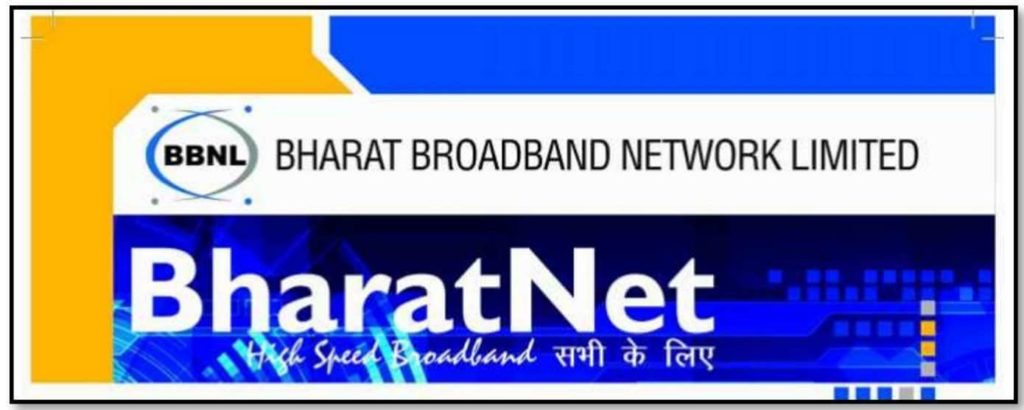
Deadlines have been modified time and again
The program was originally planned to be implemented in a phased manner. Deadlines were set by the UPA government for each of the three phases. They had ambitious deadlines to complete the entire project in two years– by 2013. This was further extended to
- Phase I – 50,000 Gram Panchayats by 31 March 2015
- Phase II- 1 lakh Gram Panchayats by March 2016
- Phase III- remaining 1 Lakh Gram Panchayats by December 2016
But, after the NDA came to power in 2014, these deadlines were extended up to March 2017. Nonetheless, the first phase of connecting more than one lakh panchayats was completed in only December 2017. The implementation was undertaken by three Central PSUs, namely, BSNL, RailTel, and Powergrid. Currently, phase – II to connect the remaining 1.5 lakh panchayats is under implementation. The government is expecting to complete the project by August 2021.

Phase II of the project is currently under execution
Under Phase -II, implementation is done through the State Model, Private Sector Model, and CPSU Model. Not only will this phase include an optimum mix of channels for connectivity (Optical Fibre Cables, Radio and Satellites), but will also be providing last-mile connectivity through Wi-Fi or similar technology to ensure that internet is available at the home/office. This is based on the recommendations of the committee on National Open Fiber Network which submitted its report in 2015.
About eight states have opted for State-led model while the satellite model is being implemented mostly in states which have a difficult terrain. Uttar Pradesh is implementing the project through both BSNL (CPSU Led) and PPP Model.
As on 06 March 2020, Optical Fiber Cables has been laid for over 4.27 lakh kilometres connecting more than 1.5 Lakh gram panchayats. Around 1.37 lakh of these have been made service ready as per the latest data on BBNL website.

Government cited various reasons in Lok Sabha for the delay in project
Even though the government had set March 2019 as the target for completion of the ‘mega‘ project, there has been a significant delay due to many reasons as listed by the government in the Lok Sabha. The reasons behind this delay as answered in Lok Sabha are as follows,
- Work began late, only in the second half of 2014 because of field survey of the widely dispersed Gram Panchayats and pilot testing of the technology model
- In phase I, only optical fibre cables were used for connection (However, the government has tried to address this issue in the second phase by using multiple media)
- Right of Way issues
- State Model is being used for implementing the project across 65,000 panchayats in 8 states which is obstructing completion under phase II. (Andhra Pradesh, Telangana, Maharashtra, Tamil Nadu, Gujarat, Jharkhand, Odisha, and Chhattisgarh are the eight states)
Funds are earmarked as a whole, not state-wise
Funds for BharatNet are allocated as a whole and not state-wise. A lump sum amount is allocated and disbursed from Universal Service Obligation Fund (USOF) to BBNL for implementation of BharatNet. USOF’s task is to make sure that people in rural areas have access to telecom connectivity at an affordable and reasonable rate. It was established in 2002.
The initial estimate for the entire project was ₹ 20,000 crores. As on 07 July 2014, USOF had released a grant of ₹ 919 crores and BBNL had utilized only ₹ 463 crores in the project. The committee on the NOFN re-estimated the total cost of the project at ₹ 72,778 crores- more than three times the initial estimate after the NDA came to power.
For Phase I, more than ₹ 9,000 crores were spent with Madhya Pradesh accounting for 11%
For phase I, an amount of ₹ 11,148 crores was approved, out of which ₹ 10,286 was allocated to BBNL. A total of ₹ 9,027 crores was spent for BharatNet phase I. State-wise expenditure is given in the following chart. Madhya Pradesh spent the most and is the only state to have spent more than ₹ 1000 crores. Maharashtra has spent the second highest with ₹ 998.9 crores. Expenses in Gujarat includes union territories- Daman and Diu, and Dadra and Nagar Haveli too.
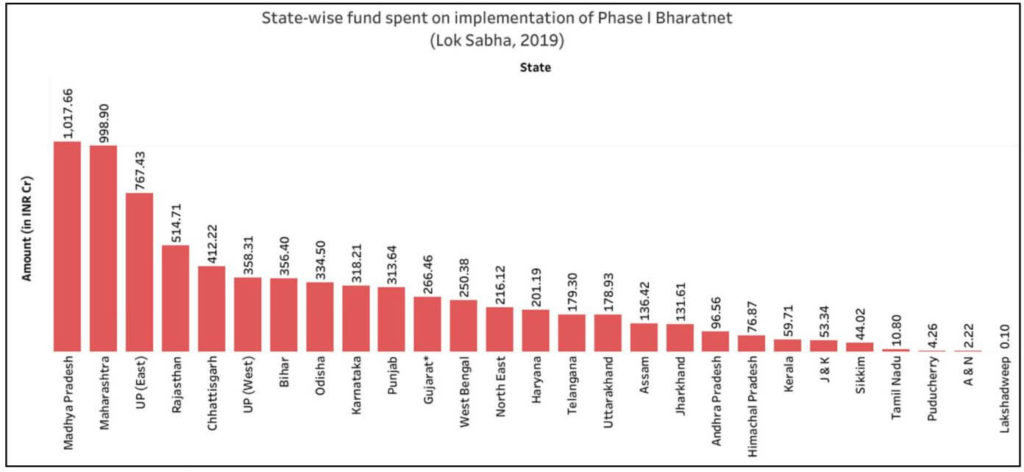
Maharashtra has received the maximum fund till date- more than 13% of amount disbursed to states
Combining the funds disbursed for both phase I & II, Maharashtra has accounted for almost ₹1,933 crores while UP and Gujarat have received more than ₹ 1,600 crores each as per Lok Sabha answer provided on 05 February 2020. Madhya Pradesh too has received more than ₹ 1,000 crores. These four states alone account for 46.5% of the amount disbursed to states. Overall, the states have been given a total of ₹ 14,313 crores. In fact, numbers suggest that including the payment towards BSNL and TCIL, a total of ₹ 19,595 crores have been disbursed. For 2020-21, the finance minister has proposed to allocate ₹ 6,000 crores for BharatNet programme.
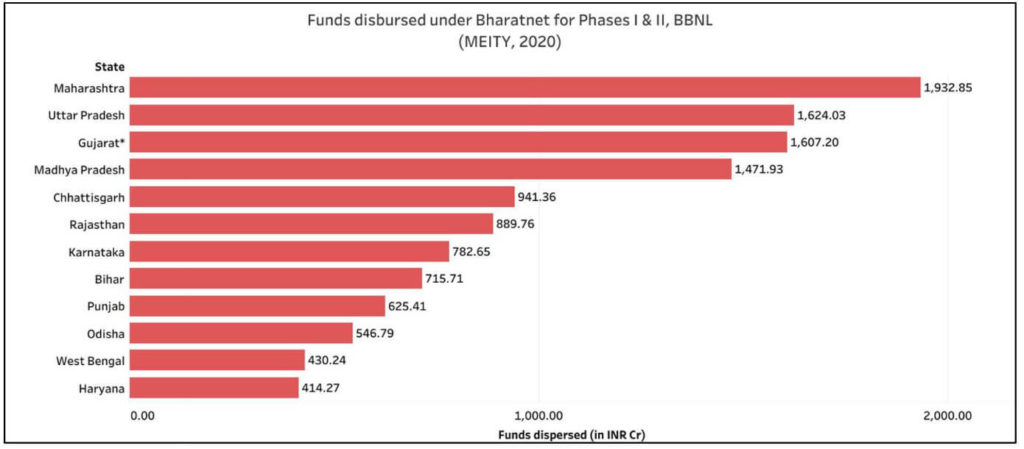
Only 59 gram panchayats covered by the end of UPA’s term
As per BBNL’s annual report, as on 31 March 2014, a pilot project was executed in 59 Gram Panchayats in only 3 states despite 2013 being the initial target to complete the project. Thus, there was very little progress during the UPA despite the hype about the project. In the subsequent financial year of 2014-15, the NDA government connected 10,955 panchayats. The number of panchayats connected each year up to 28 January 2018 has been represented in the chart below. More than 50% of the proposed panchayats were connected by the end of 2018. Latest data reveals that more than 1.5 Lakh panchayats have been connected.
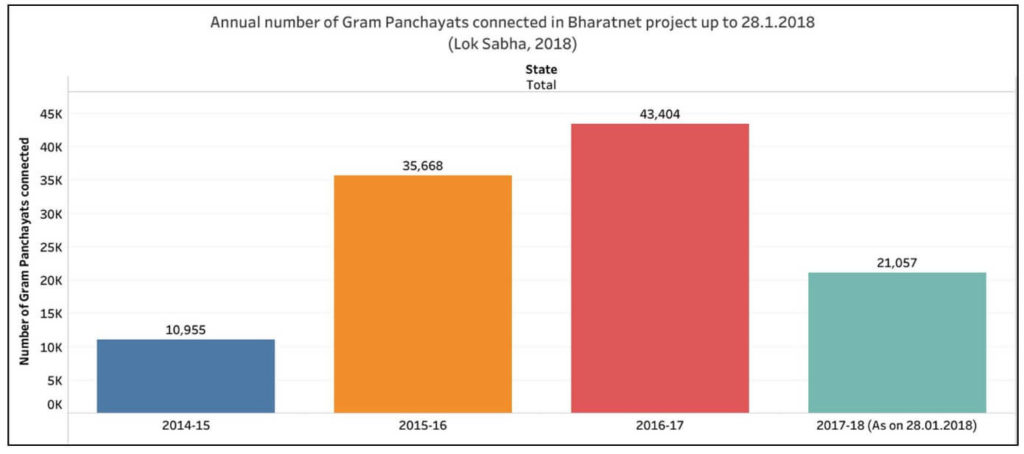
Every now and then, the BBNL website is updated with the latest status of BharatNet programme. The current status of the project is as follows:
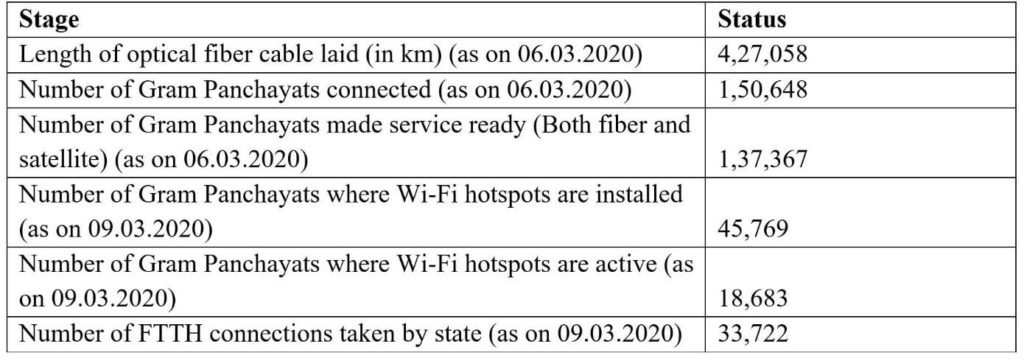
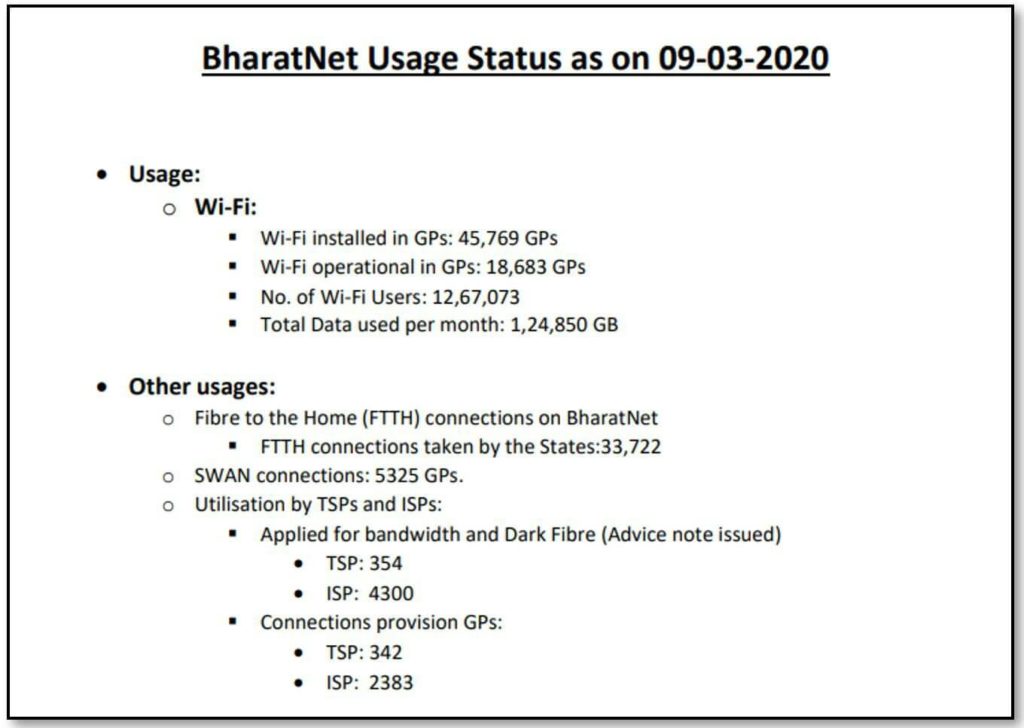
An ambitious project marred with delays
Connecting every village with the internet is an ambitious idea that has the potential to bring about a large-scale change in the lives of rural Indians. Such connectivity can have a profound impact on governance and the economy. A lot of time and money are saved since tedious processes are streamlined and made simpler, thanks to the advent of technology. Further, transparency and accessibility are two main factors which improve with technology. However, the project has been marred with delays and multiple extensions. The quality of connectivity and the range of services provided at the last mile remain the key.


